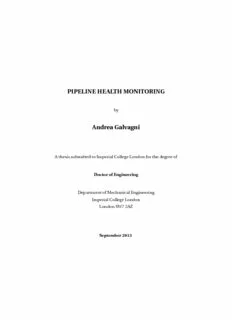
PIPELINE HEALTH MONITORING Andrea Galvagni PDF
Preview PIPELINE HEALTH MONITORING Andrea Galvagni
PIPELINE HEALTH MONITORING by Andrea Galvagni AthesissubmittedtoImperialCollegeLondonforthedegreeof DoctorofEngineering DepartmentofMechanicalEngineering ImperialCollegeLondon LondonSW72AZ September2013 Thispagehasbeenintentionallyleftblank. 2 Declaration of Originality The material presented in the thesis “Pipeline Health Monitoring” is entirely the result of my own independent research under the supervision of Professor Peter Cawley. All pub- lishedorunpublishedmaterialutilisedinthisthesishasbeengivenfullacknowledgement. AndreaGalvagni London,the6thofSeptember2013 3 Thispagehasbeenintentionallyleftblank. 4 Copyright Declaration The copyright of this thesis rests with the author and is made available under a Creative CommonsAttributionNon-CommercialNoDerivativeslicence.Researchersarefreetocopy, distributeortransmitthethesisonconditionthattheyattributeit,thattheydonotuseitfor commercialpurposesandthattheydonotalter,transformorbuilduponit. Foranyreuseor redistribution,researchersmustmakecleartoothersthelicencetermsofthiswork. 5 Thispagehasbeenintentionallyleftblank. 6 “Senonpoteteparlarebenediunapersona,nonparlatene.” RosaFalasca 7 Thispagehasbeenintentionallyleftblank. 8 Abstract Worldwide, BP operates many thousand kilometres of pipelines carrying valuable yet toxic andcorrosivefluids. Thestructuralintegrityofthesepipelinesiscrucial,asanyfailuremay result in environmental damage, economic losses and injuries to personnel. Convention- ally,pipelineintegrityisassessedonatimebasis. Thisinherentlylimitstheamountofinfor- mation available about its structural health, as any damage which develops in unexpected circumstances or while the pipeline is not being inspected may remain undetected. Such lackofinformationhindersthereliabilityofanyprognosisandofRisk-BasedInspectionand Maintenancestrategies, increasestheriskofunexpected criticaldamagedevelopmentand pipelinefailure,andforcestheuseofcostlytime-basedmaintenance,followingthesafe-life design approach. Conversely, if sufficient information about pipeline integrity were avail- able to produce reliable prognoses, then it would become possible to dramatically reduce the risk of unexpected failures and to utilise cost-efficient condition-based maintenance, whichprescribesthereplacementofapipelineonlywhenitisabouttosuffercriticaldam- age and has therefore reached the actual end of its operational life. In this way, pipeline networks would become safer and more reliable while at the same time more productive andlesscostly. ThisthesisintroducesanddemonstratesaStructuralHealthMonitoringap- proachthathasthepotentialtofilltheintegrityinformationgapandultimatelyenablethe useofcondition-basedpipelinemaintenance. Thisapproach, embodiedbyapracticalau- tomatedpipelinedamagedetectionprocedure,complementspermanentlyinstalledguided wavesensorstocreateacompletepipelinehealthmonitoringsolution.Utilisingexperimen- taldatafromapermanentlyinstalledguidedwavesensorinstalledonapurpose-builtNPS 8 Schedule 40 pipe loop facility at BP’s Naperville Campus, it is shown that the procedure isveryeffectiveatdetectingandquantifyingactualdamage,therebyachievingtheintended aimofthisthesis. 9 Thispagehasbeenintentionallyleftblank. 10
Description: